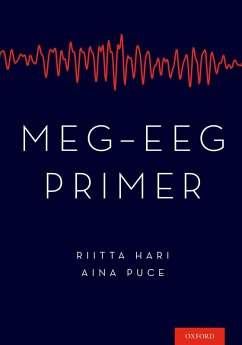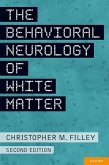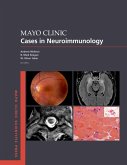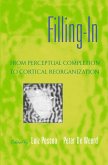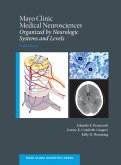

Alle Infos zum eBook verschenken

- Format: PDF
- Merkliste
- Auf die Merkliste
- Bewerten Bewerten
- Teilen
- Produkt teilen
- Produkterinnerung
- Produkterinnerung

Hier können Sie sich einloggen

Bitte loggen Sie sich zunächst in Ihr Kundenkonto ein oder registrieren Sie sich bei bücher.de, um das eBook-Abo tolino select nutzen zu können.
Magnetoencephalography (MEG) and electroencephalography (EEG) provide complementary views to the neurodynamics of healthy and diseased human brains. Both methods are totally noninvasive and can track with millisecond temporal resolution spontaneous brain activity, evoked responses to various sensory stimuli, as well as signals associated with the performance of motor, cognitive and affective tasks. MEG records the magnetic fields, and EEG the potentials associated with the same neuronal currents, which however are differentially weighted due to the physical and physiological differences…mehr
- Geräte: PC
- mit Kopierschutz
- eBook Hilfe
- Größe: 47.69MB
![MEG - EEG Primer (eBook, PDF) MEG - EEG Primer (eBook, PDF)]() Riitta HariMEG - EEG Primer (eBook, PDF)46,95 €
Riitta HariMEG - EEG Primer (eBook, PDF)46,95 €![The Art and Science of Compassion, A Primer (eBook, PDF) The Art and Science of Compassion, A Primer (eBook, PDF)]() Agnes M. F. WongThe Art and Science of Compassion, A Primer (eBook, PDF)23,95 €
Agnes M. F. WongThe Art and Science of Compassion, A Primer (eBook, PDF)23,95 €![The Behavioral Neurology of White Matter (eBook, PDF) The Behavioral Neurology of White Matter (eBook, PDF)]() Christopher FilleyThe Behavioral Neurology of White Matter (eBook, PDF)79,95 €
Christopher FilleyThe Behavioral Neurology of White Matter (eBook, PDF)79,95 €![Mayo Clinic Cases in Neuroimmunology (eBook, PDF) Mayo Clinic Cases in Neuroimmunology (eBook, PDF)]() Andrew McKeonMayo Clinic Cases in Neuroimmunology (eBook, PDF)47,95 €
Andrew McKeonMayo Clinic Cases in Neuroimmunology (eBook, PDF)47,95 €![Filling-In (eBook, PDF) Filling-In (eBook, PDF)]() Filling-In (eBook, PDF)58,95 €
Filling-In (eBook, PDF)58,95 €![Mayo Clinic Medical Neurosciences (eBook, PDF) Mayo Clinic Medical Neurosciences (eBook, PDF)]() Eduardo E. BenarrochMayo Clinic Medical Neurosciences (eBook, PDF)117,95 €
Eduardo E. BenarrochMayo Clinic Medical Neurosciences (eBook, PDF)117,95 €![The Neurology of Autism (eBook, PDF) The Neurology of Autism (eBook, PDF)]() The Neurology of Autism (eBook, PDF)24,95 €
The Neurology of Autism (eBook, PDF)24,95 €-
-
-
Dieser Download kann aus rechtlichen Gründen nur mit Rechnungsadresse in A, B, BG, CY, CZ, D, DK, EW, E, FIN, F, GR, HR, H, IRL, I, LT, L, LR, M, NL, PL, P, R, S, SLO, SK ausgeliefert werden.
- Produktdetails
- Verlag: Oxford University Press
- Seitenzahl: 304
- Erscheinungstermin: 20. März 2017
- Englisch
- ISBN-13: 9780190497781
- Artikelnr.: 48199375
- Verlag: Oxford University Press
- Seitenzahl: 304
- Erscheinungstermin: 20. März 2017
- Englisch
- ISBN-13: 9780190497781
- Artikelnr.: 48199375
* PREAMBLE
* SECTION 1
* CHAPTER 1: INTRODUCTION
* MEG and EEG Setups
* Comparison of MEG and EEG
* Structure of this Primer
* CHAPTER 2: INSIGHTS INTO THE HUMAN BRAIN
* Overview of the Human Brain
* How to Obtain Information About Brain Function
* Timing in Human Behavior
* Functional Structure of the Human Cerebral Cortex
* Communication Between Brain Areas
* Thalamocortical Connections
* Intra-Brain Connectivity
* Electric Signaling in Neurons
* Membrane Potential
* Action Potentials
* Postsynaptic Potentials
* CHAPTER 3: BASIC PHYSICS AND PHYSIOLOGY OF MEG AND EEG
* An Overview of MEG and EEG Signal Generation
* Charges and Electric Current
* Ohm's and Kirchoff's Laws
* Relationship Between Current and Magnetic Field
* Superconductivity
* Inverse Problem
* Source Currents
* Primary Current
* Layers, Open Fields, and Closed Fields
* Intracortical Cancellation
* Volume Conduction
* Spherical Head Model
* Some General Points About Source Localization
* CHAPTER 4: AN OVERVIEW OF EEG AND MEG
* Historical Aspects
* Early EEG Recordings
* Early MEG Recordings
* Brain Rhythms
* Evoked and Event-Related Responses
* SECTION 2
* CHAPTER 5: INSTRUMENTATION FOR MEG AND EEG
* EEG Instrumentation
* Electrodes
* EEG Amplifiers
* Differential Amplifiers, Common Mode Rejection, and Amplifier Input
Impedances
* Standard Electrode Positions
* Effects of Reference Electrode on Potential Distribution
* Re-Referencing Relative to an Average Reference
* MEG Instrumentation
* Squids and Squid Electronics
* Flux Transformers and Their Configuration
* Shielding
* Other Means to Maintain a Noise-Free Environment
* Stimulators and Monitoring Devices
* Auditory Stimulators
* Visual Stimulators
* Somatosensory Stimulators
* Stimulators for Inducing Acute Pain
* Passive-Movement Stimulators (Proprioception Stimulation)
* Monitoring Devices
* Future Developments of EEG and MEG Instrumentation
* Developments in EEG
* Developments in MEG
* CHAPTER 6. PRACTICALITIES OF DATA COLLECTION
* General Principles of Good Experimentation
* Replicability Checks
* EEG Recordings: The Practice
* Electrodes, Skin Preparation, and Electrode-Impedance Measurement
* Post-Recording Infection Control
* MEG Recordings: The Practice
* Measurement of MEG Sensor and EEG Electrode Positions
* Locations of MEG Sensors and EEG Electrodes
* Electrical Safety
* CHAPTER 7: DATA ACQUISITION AND PREPROCESSING
* Filtering
* Data Sampling (Analog-To-Digital Conversion)
* CHAPTER 8: ARTIFACTS
* General
* Artifact-Removal Methods
* Blind Source Separation and Independent-Component Analysis
* Signal-Space Projection (SSP) and Temporal Signal-Space Separation
Tsss (For MEG)
* Eye-Related Artifacts
* Generation and Recognition of Eye Movement and Eye Blink Artifacts
* Saccadic and Microsaccade Artifacts
* Electroretinogram and Magnetoretinogram
* Removal of Eye-Related Artifacts
* Muscle Artifacts
* Generation and Recognition
* Removal
* Cardiac Artifacts
* Generation and Recognition
* Removal
* Respiration-Related Artifacts
* Generation and Recognition
* Sweating
* Generation, Recognition, and Removal
* Non-Physiological Artifacts
* Power-Line Noise and its Removal
* Response-Box Artifacts
* EEG-Electrode and MEG-Sensor-Related Artifacts
* How to be Sure that the Signals come from the Brain
* CHAPTER 9: ANALYZING THE DATA
* General
* Data Inspection and Pre-Processing
* Signal Averaging of MEG/EEG Data
* Signal-To-Noise Considerations
* Segmentation
* Amplitude and Latency Measures
* Issues Related to Cross-Group Averaging and Assessment of Group
Differences
* Topographic Maps of EEG and MEG Activity
* Whole-Head Statistical Analysis of EEG Data
* Analysis of Spontaneous Activity and Single-Trial Data
* General
* Evoked Versus Induced Activity
* MEG/EEG Signal Level and Power
* Event-Related Desynchronization and Synchronization, and Temporal
Spectral Evolution
* Time-Frequency Analyses
* Phase Resetting and Models of Evoked Activity
* Coherence and Other Measures of Association
* Cross-Frequency Coupling
* Global Field Power, Dissimilarity, and Brain Microstates
* Source Modeling
* The Forward and Inverse Problems in MEG and EEG
* Head Models
* Single-Dipole Model and Model Validity
* Goodness-of-Fit and Confidence Limits of the Model
* Spatial Resolution
* Source Extent
* Multidipole Models, Distributed Models, and Beamformers
* Hypothesis Testing with Predetermined Source Locations
* Effect of Synchrony
* Changes in Orientation/Tilting
* Assessments of Effective Connectivity
* Common Pitfalls in Data Analysis and Interpretation
* Interpretation of MEG/EEG Data
* SECTION 3
* CHAPTER 10: BRAIN RHYTHMS
* General
* Alpha Rhythm of the Posterior Cortex
* Mu Rhythm of the Sensorimotor Cortex
* Tau Rhythm in the Auditory Cortex
* Beta Rhythm
* Theta Rhythm
* Gamma Rhythms
* Delta-Band Activity and Ultra-Slow Oscillations
* Coupling Between Different Brain Rhythms
* Changes in Brain Rhythms During Sleep
* Effects of Anesthesia and Other Drugs on EEG/MEG
* CHAPTER 11: EVOKED AND EVENT-RELATED RESPONSES
* General
* An Initial Example
* Nomenclature of Evoked Responses and Brain Rhythms
* Effects of Interstimulus Interval and Stimulus Timing
* Effects of Other Stimulus Parameters
* CHAPTER 12: AUDITORY RESPONSES
* Aspects of Auditory Stimulation
* Auditory Brainstem Responses
* Middle-Latency Auditory-Evoked Responses
* Long-Latency Auditory Evoked Responses
* Auditory Steady-State Responses
* Frequency Tagging
* CHAPTER 13: VISUAL RESPONSES
* Visual Stimuli
* Transient Visual Responses
* Assessing the Ventral Visual Stream
* Assessing the Dorsal Visual Stream
* Steady-State Visual Responses
* CHAPTER 14: SOMATOSENSORY RESPONSES 304
* Compound Action Potentials and Fields of Peripheral Nerves
* Responses from SI Cortex
* Responses from Posterior Parietal Cortex
* Responses from SII Cortex
* Somatosensory Steady-State Responses
* High-Frequency Oscillations (Hfos) in SI
* Pain and Nociceptive Responses
* CHAPTER 15: OTHER SENSORY RESPONSES and MULTISENSORY INTERACTIONS
* Visceral Responses
* Olfactory and Gustatory Responses
* Multisensory Interaction
* General
* Audiotactile Interaction: An MEG Case Study
* Multisensory Integration of Human Communication
* Multisensory Integration Reflected in Spontaneous MEG/EEG Activity
* CHAPTER 16: MOTOR FUNCTION
* Movement-Related Readiness Potentials and Fields
* Coherence Between Brain Activity and Movements/Muscles
* General
* Cortex-Muscle Coherence
* Corticokinematic Coherence
* Corticovocal Coherence
* CHAPTER 17: BRAIN SIGNALS RELATED TO CHANGE DETECTION
* General
* Contingent Negative Variation (CNV)
* Mismatch Negativity and Field (MMN, MMF)
* P300 Responses
* N400 Responses
* Error-Related Negativity (ERN)
* CHAPTER 18: THE SOCIAL BRAIN
* Theoretical Framework
* Responses to Emotions Depicted by Faces and Bodies
* Action Viewing and Mirroring
* Hyperscanning
* Verbal Communication
* CHAPTER 19: BRAIN DISORDERS
* General Remarks
* Epilepsy
* Preoperative Mapping
* Functional Identification of the Central Sulcus
* Anatomical Identification of the Central Sulcus
* Hemispheric Dominance for Speech and Language
* Stroke
* Critically Ill Patients
* Coma
* Brain Death
* CHAPTER 20: MEG/EEG IN THE STUDY OF BRAIN FUNCTION
* Advantages of MEG and EEG
* Disadvantages of MEG and EEG
* Combining MEG and EEG
* Combining MEG/EEG with MRI/fMRI
* EEG During Non-Invasive Brain Stimulation
* CHAPTER 21: LOOKING TO THE FUTURE
* Decoding of Brain States
* Travelling Light
* Data Governance
* Better Analysis of Behavior
* Modeling at Different Levels
* How Your MEG and EEG Work Can Make an Impact on Science
* Index
* PREAMBLE
* SECTION 1
* CHAPTER 1: INTRODUCTION
* MEG and EEG Setups
* Comparison of MEG and EEG
* Structure of this Primer
* CHAPTER 2: INSIGHTS INTO THE HUMAN BRAIN
* Overview of the Human Brain
* How to Obtain Information About Brain Function
* Timing in Human Behavior
* Functional Structure of the Human Cerebral Cortex
* Communication Between Brain Areas
* Thalamocortical Connections
* Intra-Brain Connectivity
* Electric Signaling in Neurons
* Membrane Potential
* Action Potentials
* Postsynaptic Potentials
* CHAPTER 3: BASIC PHYSICS AND PHYSIOLOGY OF MEG AND EEG
* An Overview of MEG and EEG Signal Generation
* Charges and Electric Current
* Ohm's and Kirchoff's Laws
* Relationship Between Current and Magnetic Field
* Superconductivity
* Inverse Problem
* Source Currents
* Primary Current
* Layers, Open Fields, and Closed Fields
* Intracortical Cancellation
* Volume Conduction
* Spherical Head Model
* Some General Points About Source Localization
* CHAPTER 4: AN OVERVIEW OF EEG AND MEG
* Historical Aspects
* Early EEG Recordings
* Early MEG Recordings
* Brain Rhythms
* Evoked and Event-Related Responses
* SECTION 2
* CHAPTER 5: INSTRUMENTATION FOR MEG AND EEG
* EEG Instrumentation
* Electrodes
* EEG Amplifiers
* Differential Amplifiers, Common Mode Rejection, and Amplifier Input
Impedances
* Standard Electrode Positions
* Effects of Reference Electrode on Potential Distribution
* Re-Referencing Relative to an Average Reference
* MEG Instrumentation
* Squids and Squid Electronics
* Flux Transformers and Their Configuration
* Shielding
* Other Means to Maintain a Noise-Free Environment
* Stimulators and Monitoring Devices
* Auditory Stimulators
* Visual Stimulators
* Somatosensory Stimulators
* Stimulators for Inducing Acute Pain
* Passive-Movement Stimulators (Proprioception Stimulation)
* Monitoring Devices
* Future Developments of EEG and MEG Instrumentation
* Developments in EEG
* Developments in MEG
* CHAPTER 6. PRACTICALITIES OF DATA COLLECTION
* General Principles of Good Experimentation
* Replicability Checks
* EEG Recordings: The Practice
* Electrodes, Skin Preparation, and Electrode-Impedance Measurement
* Post-Recording Infection Control
* MEG Recordings: The Practice
* Measurement of MEG Sensor and EEG Electrode Positions
* Locations of MEG Sensors and EEG Electrodes
* Electrical Safety
* CHAPTER 7: DATA ACQUISITION AND PREPROCESSING
* Filtering
* Data Sampling (Analog-To-Digital Conversion)
* CHAPTER 8: ARTIFACTS
* General
* Artifact-Removal Methods
* Blind Source Separation and Independent-Component Analysis
* Signal-Space Projection (SSP) and Temporal Signal-Space Separation
Tsss (For MEG)
* Eye-Related Artifacts
* Generation and Recognition of Eye Movement and Eye Blink Artifacts
* Saccadic and Microsaccade Artifacts
* Electroretinogram and Magnetoretinogram
* Removal of Eye-Related Artifacts
* Muscle Artifacts
* Generation and Recognition
* Removal
* Cardiac Artifacts
* Generation and Recognition
* Removal
* Respiration-Related Artifacts
* Generation and Recognition
* Sweating
* Generation, Recognition, and Removal
* Non-Physiological Artifacts
* Power-Line Noise and its Removal
* Response-Box Artifacts
* EEG-Electrode and MEG-Sensor-Related Artifacts
* How to be Sure that the Signals come from the Brain
* CHAPTER 9: ANALYZING THE DATA
* General
* Data Inspection and Pre-Processing
* Signal Averaging of MEG/EEG Data
* Signal-To-Noise Considerations
* Segmentation
* Amplitude and Latency Measures
* Issues Related to Cross-Group Averaging and Assessment of Group
Differences
* Topographic Maps of EEG and MEG Activity
* Whole-Head Statistical Analysis of EEG Data
* Analysis of Spontaneous Activity and Single-Trial Data
* General
* Evoked Versus Induced Activity
* MEG/EEG Signal Level and Power
* Event-Related Desynchronization and Synchronization, and Temporal
Spectral Evolution
* Time-Frequency Analyses
* Phase Resetting and Models of Evoked Activity
* Coherence and Other Measures of Association
* Cross-Frequency Coupling
* Global Field Power, Dissimilarity, and Brain Microstates
* Source Modeling
* The Forward and Inverse Problems in MEG and EEG
* Head Models
* Single-Dipole Model and Model Validity
* Goodness-of-Fit and Confidence Limits of the Model
* Spatial Resolution
* Source Extent
* Multidipole Models, Distributed Models, and Beamformers
* Hypothesis Testing with Predetermined Source Locations
* Effect of Synchrony
* Changes in Orientation/Tilting
* Assessments of Effective Connectivity
* Common Pitfalls in Data Analysis and Interpretation
* Interpretation of MEG/EEG Data
* SECTION 3
* CHAPTER 10: BRAIN RHYTHMS
* General
* Alpha Rhythm of the Posterior Cortex
* Mu Rhythm of the Sensorimotor Cortex
* Tau Rhythm in the Auditory Cortex
* Beta Rhythm
* Theta Rhythm
* Gamma Rhythms
* Delta-Band Activity and Ultra-Slow Oscillations
* Coupling Between Different Brain Rhythms
* Changes in Brain Rhythms During Sleep
* Effects of Anesthesia and Other Drugs on EEG/MEG
* CHAPTER 11: EVOKED AND EVENT-RELATED RESPONSES
* General
* An Initial Example
* Nomenclature of Evoked Responses and Brain Rhythms
* Effects of Interstimulus Interval and Stimulus Timing
* Effects of Other Stimulus Parameters
* CHAPTER 12: AUDITORY RESPONSES
* Aspects of Auditory Stimulation
* Auditory Brainstem Responses
* Middle-Latency Auditory-Evoked Responses
* Long-Latency Auditory Evoked Responses
* Auditory Steady-State Responses
* Frequency Tagging
* CHAPTER 13: VISUAL RESPONSES
* Visual Stimuli
* Transient Visual Responses
* Assessing the Ventral Visual Stream
* Assessing the Dorsal Visual Stream
* Steady-State Visual Responses
* CHAPTER 14: SOMATOSENSORY RESPONSES 304
* Compound Action Potentials and Fields of Peripheral Nerves
* Responses from SI Cortex
* Responses from Posterior Parietal Cortex
* Responses from SII Cortex
* Somatosensory Steady-State Responses
* High-Frequency Oscillations (Hfos) in SI
* Pain and Nociceptive Responses
* CHAPTER 15: OTHER SENSORY RESPONSES and MULTISENSORY INTERACTIONS
* Visceral Responses
* Olfactory and Gustatory Responses
* Multisensory Interaction
* General
* Audiotactile Interaction: An MEG Case Study
* Multisensory Integration of Human Communication
* Multisensory Integration Reflected in Spontaneous MEG/EEG Activity
* CHAPTER 16: MOTOR FUNCTION
* Movement-Related Readiness Potentials and Fields
* Coherence Between Brain Activity and Movements/Muscles
* General
* Cortex-Muscle Coherence
* Corticokinematic Coherence
* Corticovocal Coherence
* CHAPTER 17: BRAIN SIGNALS RELATED TO CHANGE DETECTION
* General
* Contingent Negative Variation (CNV)
* Mismatch Negativity and Field (MMN, MMF)
* P300 Responses
* N400 Responses
* Error-Related Negativity (ERN)
* CHAPTER 18: THE SOCIAL BRAIN
* Theoretical Framework
* Responses to Emotions Depicted by Faces and Bodies
* Action Viewing and Mirroring
* Hyperscanning
* Verbal Communication
* CHAPTER 19: BRAIN DISORDERS
* General Remarks
* Epilepsy
* Preoperative Mapping
* Functional Identification of the Central Sulcus
* Anatomical Identification of the Central Sulcus
* Hemispheric Dominance for Speech and Language
* Stroke
* Critically Ill Patients
* Coma
* Brain Death
* CHAPTER 20: MEG/EEG IN THE STUDY OF BRAIN FUNCTION
* Advantages of MEG and EEG
* Disadvantages of MEG and EEG
* Combining MEG and EEG
* Combining MEG/EEG with MRI/fMRI
* EEG During Non-Invasive Brain Stimulation
* CHAPTER 21: LOOKING TO THE FUTURE
* Decoding of Brain States
* Travelling Light
* Data Governance
* Better Analysis of Behavior
* Modeling at Different Levels
* How Your MEG and EEG Work Can Make an Impact on Science
* Index
